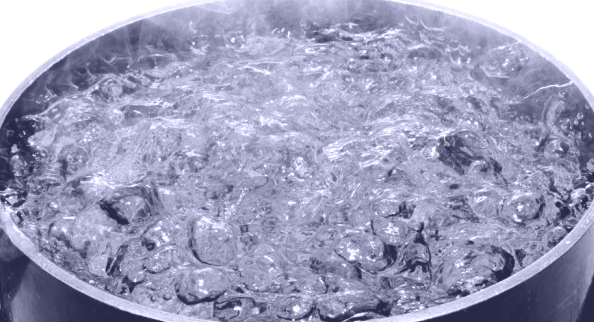Pre-Boiling Water Treatment
Water that has high calcium and bicarbonate content and low chloride and sulfate content, has high TEMPORARY HARDNESS. That water can be boiled and a portion of the hardness and alkalinity will drop out as chalk. So, how do you do this treatment and what might the result be?
How to do it
Pre-boiling water has been practiced by brewers for centuries. It’s easily accomplished using the equipment that a brewer already has: kettle and heat source. Here’s how to do it effectively.
The pre-boiling process works by driving off the dissolved CO2 from the water which leaves calcium and carbonate ions that precipitate as chalk. While the solubility of CO2 in boiling water is zero, it would seem that this reaction should be complete as soon as the water boils. But actual practice has shown that it takes several minutes of boiling to scrub CO2 from water. Historic brewing texts recommend 15 minutes of boiling, but it appears that 10 minutes could do.
After boiling, the water is left to cool and settle. It will take a while for the dissolved calcium and carbonate to precipitate as chalk. One technique to speed the process is to add powdered chalk to the water to serve as nucleation points. That added chalk does not dissolve into the water, so don’t worry about this counter-intuitive addition. As the chalk forms and settles to the bottom of the vessel, the water will clear. As soon as the water clears, it should be poured or siphoned off the cloudy water and sediment. Don’t let the clear water sit on the sediment too long or the chalk will eventually dissolve back into the water.
What will your water quality be after pre-boiling?Only the calcium and bicarbonate content of your water will be reduced. All other ion concentrations will remain unchanged. The practical limit for pre-boiling reduces the water’s bicarbonate content to between 60 and 80 ppm, although very good practices can reduce that to as little as 50 ppm. Therefore, the quantity of chalk that can be precipitated will be based on the difference between the starting and ending bicarbonate content. A reasonable assumption is to use an 80 ppm ending bicarbonate concentration since that allows for more error in the process. Alkalinity test kits can be used to assess the alkalinity reduction and the ending calcium content for the decarbonated water can be calculated using the following formula (all values in ppm):
The Supporter's version of Bru'n Water has this calculator incorporated.
While that equation suggests that the calcium concentration could be reduced to zero or below, the practical minimum calcium concentration achievable through pre-boiling is about 12 ppm. If the calculated calcium concentration is lower than 12 ppm when using an ending 80 ppm bicarbonate assumption, the ending bicarbonate concentration must be increased until at least 12 ppm calcium concentration is calculated. The Munich water profile is a case in point. Decarbonating that water to 80 ppm bicarbonate would leave about 7 ppm calcium in the water, which is below the practical limit. Therefore, the practical ending bicarbonate concentration must be increased to about 95 ppm to leave the treated water with 12 ppm calcium. An alkalinity test kit is a good tool for estimating what the ending alkalinity content actually is and calculating the ending calcium content.
While pre-boiling is a time and energy consuming process, its simplicity makes it a useful treatment for brewers that have high temporary hardness water.
